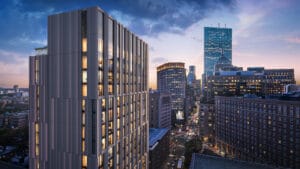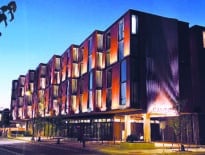
Greystar’s 212 Stuart St. tower, nearing completion on the edge of Bay Village, includes 126 apartments in a 150,000-square-foot structure. Image courtesy of Greystar
Boston is a city rich with history. For many, this is what makes it so special. The new and old often coexist, allowing traditions to live on and contemporary culture to thrive.
Boston’s revered past sometimes creates a barrier to change, however, especially for those with deep, sentimental attachments to maintaining the aesthetics of years past.
Back Bay, in particular, has been one of our city’s most desirable neighborhoods for decades, coupled with a rich and exciting history. Surrounded by stunning and distinct architecture, public transit, unmatched walkability and world-class dining and retail options, it’s unsurprising that space is in such high demand there. Not to mention, the city of Boston itself continues to climb U.S. News and World Report’s rankings of the top places to live in the U.S., jumping from spot 31 to 18 in a single year.
With this demand comes the need for housing. Our city’s thriving industries, including the life sciences, tech and financial services, have created a surplus of high-earning professionals clamoring to call enticing neighborhoods like Back Bay home. Developing a multifamily community in this historic neighborhood, where residents expect distinctive charm and character, is a generational opportunity that serves as a great example of the responsibilities and considerations that come with developing new structures in a prominent area.
Design Reflects a Crossroads
For Greystar, 212 Stuart St. represented the company’s first ground-up development in Boston after purchasing the site and entitlements in early 2020 from Transom Real Estate. The site came with the highly unique, albeit challenging, opportunity to construct a modern high-rise community at the intersection of the well-established neighborhoods of Bay Village and Back Bay. In turn, this meant Greystar and its inventive design partners at Sasaki, Höwler + Yoon and Elizabeth Stuart were presented with a chance to redefine what luxury development could mean in a historic neighborhood.
The building itself is situated between Arlington and Charles Streets at the crossroads of Back Bay and Bay Village, which means it has a presence in each neighborhood. As a result, 212 Stuart St. was designed to simultaneously reflect both, but with a bold perspective on contemporary living.
The side facing the “high spine” of Back Bay more heavily features glazing to complement its surroundings, whereas the side leading to Bay Village pays homage the low-rise residential buildings found within the neighborhood. This is further accentuated with the inclusion of two walk-up townhouses, which are rare for a high-rise, but ubiquitous in Bay Village. Their inclusion served the two-fold goal of achieving harmony with the neighborhood aesthetic while also providing active ground floors and a point of distinction for 212 Stuart St.
Tasteful Addition to the Cityscape
With 126 residential units and ground-floor retail space, this 19-story, roughly 150,000-square-foot development is an iconic and modern addition to Boston’s skyline that feels reminiscent of the past. 212 Stuart St. plays a careful balancing act, not only in its allusion to its surroundings, but also with its introduction to Boston’s skyline. Because so much attention is paid to the building’s interaction with the ground plane and nearby structures, it tastefully rises and its addition to the cityscape is backed by its cohesion with the local character.

Ryan Souls
Another facet of the building that plays into the historic yet modern immersion is its amenities. While many communities offer high-end amenities, 212 Stuart St. points to a deeper understanding of the neighborhood and residents who call it home. Akin to Back Bay and Bay Village’s effortless and elegant convenience, 212 Stuart St. is ushering in a new era of connectivity with complimentary, pre-installed high-speed Wi-Fi. Smart home technology, high-tech fitness offerings and captivating entertaining spaces, which are essential conveniences for today’s luxury renters, create an unparalleled living experience that evokes the fabric of the surroundings.
It’s no secret that Boston needs more housing, and we should be exploring every opportunity to add to the supply. This certainly means change, but, done right, change can coexist with the status quo. Understanding and respecting the existing residency is paramount and should be the foundation of any development. We believe 212 Stuart Street serves as a blueprint for this model. Careful study of the surrounding environment informed every decision made on the project, and the end result is a community that possesses the aesthetic charm of the past with modern luxuries befitting its ZIP code.
Ryan Souls is development director at Greystar in Boston.





